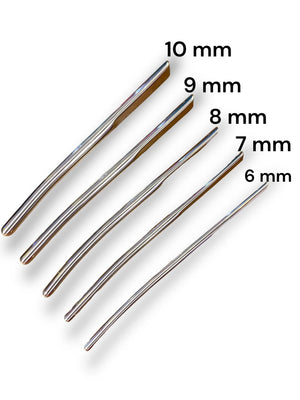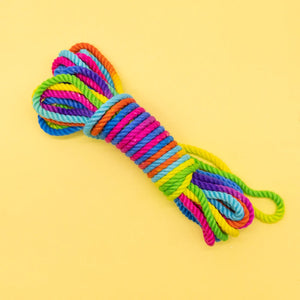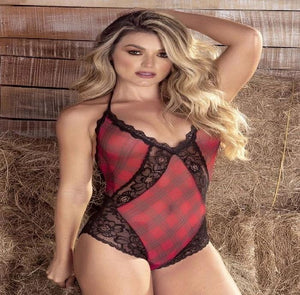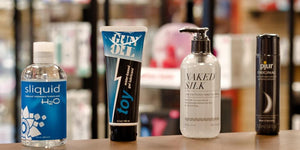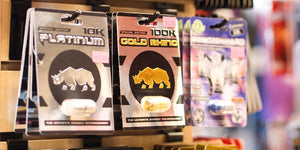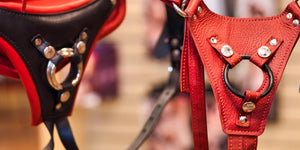Shopping for Floggers

If you're new to the BDSM scene - or just new to the idea of using a flogger as a way to give someone pleasure - the options available for something as seemingly simple as a flogger can be overwhelming. Compared to crops, paddles, slappers, and canes, the flogger has the most options of any non-electric tool in the sexy toolbox.
Here is what you'll need to know to understand the options and how to choose the flogger for your needs.
Construction - Floggers consist of strands of leather (or sometimes other materials) called falls. The falls are attached to a handle, or hilt, also wrapped with leather for easier gripping. The hilt sometimes has a ball that separates it from the falls, and another ball on the opposite end, called the pommel. Pommels can have a loop or ring for hanging the flogger when not in use.
Sensation - Floggers generate two main kinds of sensation: sting or thud. Sting is exactly what it sounds like: a sharp, stinging sensation that fades over time. Thud is a deeper, duller sensation than sting, and can feel more forceful. (Think of it like a slap versus a punch.) Despite the intense sensations they create, neither type of flogger causes lasting damage to the body when used properly.
Unbalanced vs Balanced - In a well-balanced flogger, the handle offsets the weight of the falls. This puts the balance point at the inside leading edge of the handle and puts less stress on the user's wrist. Unbalanced floggers don't do this, and after a while the odd weight distribution will lead to arm fatigue. Balancing adds to the flogger's price tag, but it’s a requirement for anyone who enjoys long sessions.
Types of Leather - The type of leather makes a huge difference in the feel of the flogger. Keep in mind that leather is a natural product, and there will be variation from one batch to the next. Comparing two toys made from oiled leather, one might be a bit thicker than the other, or stiffer, or harder, or softer, or different shades of black.
- Suede is soft leather and quite flexible, delivering a nice thud mixed with just a little sting.
-
Oiled Leather is the most serious of all the possible leathers. It's somewhat stiff and capable of delivering moderate to severe sting (see Thickness below for more details). This is the tool of choice for experienced players who are into major sting and possibly some pain. Floggers made of oiled leather can deliver such intense sensation that many people use a different flogger for the warm-up and cool-down parts of a scene.
- Combo means that a flogger has falls made from a combination of leathers, usually half are suede and half are oiled leather. This can provide a very pleasant mixture of sting and thud sensations in a single blow.
- Deer skin is thin as cloth, light as a feather, and soft as silk. It has a very light thud with virtually no sting to it. It’s just the thing for partners who aren't into pain, or for the end of a very intense session when the nerves are already singing.
- Elk is soft like suede, and a bit thicker than cow hide. With a medium thud and light sting, it's perfect for warming up or ending a session
- Buffalo (American Bison) is very heavy, often three to four times as thick as cowhide, and gives a deep thud with little sting. Not recommended for the weak-of-arm to wield for any length of time, or to be used on the easily-bruised (unless you like to wear your stripes as badges of pride.)
- Rabbit is softer than deer skin and almost always has the fur still attached. It’s virtually incapable of causing any sting and is so light that there’s hardly any thud either. Great for anyone who is into sensation play.
-
Non-leather floggers made of chain, nylon straps, rubber strands, and various types of rope are other options. The list of possible materials is endless. These you’ll need to judge for yourself. Evaluate the heaviness of the material, its flexibility, roughness, and how easy it is to grip.
Fall Width - The width of each fall changes how it feels when it strikes. Narrower falls create more sting, and wider falls make more thud on impact. The most common width is ½” especially for deer, elk, and suede, while buffalo runs 3/4" to 1" wide. Because oiled leather creates the most sting, it’s also the type most often available in a ¼” width that makes the sharpest sting possible.
Fall Count - The last thing to consider is how many falls are on the flogger. With more falls, there is an added ‘thud’ component to each strike as well as the possibility of spreading the sensation to a larger area (depending on how the blow was aimed). With fewer falls, the sharper the sensation (which adds to the sting factor) and the smaller area that is struck.
Now, armed with this knowledge, when you shop for floggers it's as easy as ordering at Starbucks. Now go out and make someone's skin sing.
- Tags: BDSM Floggers Kink Shopping Guide
- Staff
